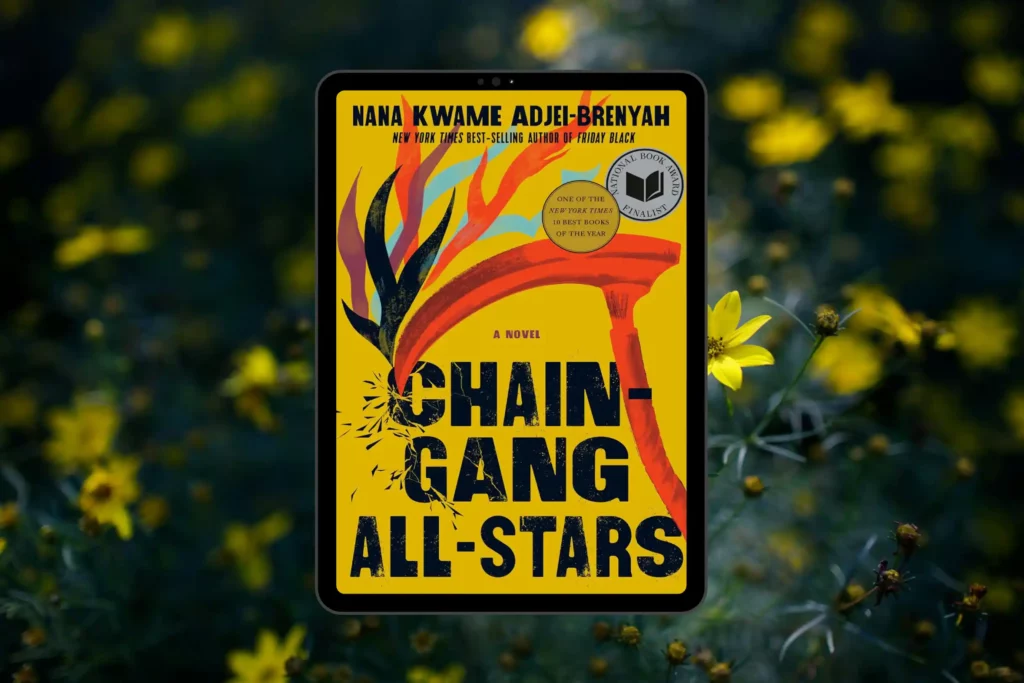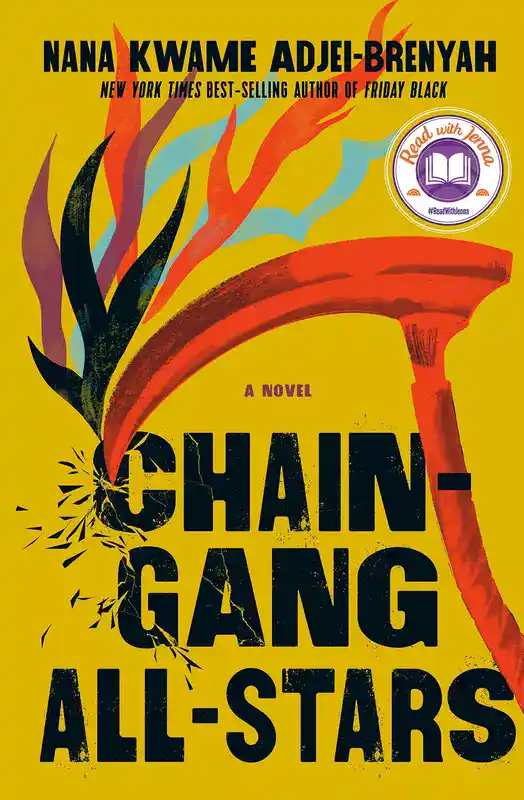This post may contain affiliate links. Read more here.

Note: the following discussion guide contains spoilers, as well as references to critical plot points and the conclusion of Chain Gang All Stars by Nana Kwame Adjei-Brenyah.
Chain-Gang All-Stars, published in 2023, is a futuristic novel by Nana Kwame Adjei-Brenyah that takes place in an alternate United States.
In this world, people facing either execution or 25-plus years in prison can choose to become Gladiators, competing in deadly matches against other inmates for three years. If they survive, they can earn a pardon and rejoin society.
Chain Gang All Stars by Nana Kwame Adjei-Brenyah
The novel explores the harsh realities of the penal system, entertainment sports, and capitalism, while also touching on themes of redemption, love, and self-forgiveness as alternatives to the cycle of violence and self-loathing promoted by the current penal system.
In this guide we will go through the complete summary and ending explanation for Chain Gang All Stars by Nana Kwame Adjei-Brenyah. Enjoy! ✨
Summary | Ending Explained | Book Club Questions
Chain Gang All Stars Summary
In an alternate present-day US, those facing the death penalty or long prison terms can join the Criminal Action Penal Entertainment (CAPE) program. Participants engage in televised death matches against other inmates, aiming to survive three years and earn a pardon for their crimes.
Loretta Thurwar, tormented by prison conditions and a painful device called the Influencer, joins CAPE, thinking she deserves to die for a past murder. However, her opponent, Melancholia Bishop, lets her win, disrupting the usual pattern.
Three years later, Thurwar, now on the Angola-Hammond Chain (A-Hamm) with Hamara Stacker (Hurricane Staxxx), is in love and close to earning her freedom. Staxxx is also progressing well. During a special BlackOut night, a fellow Link in their Chain, Sunset Harkless, is killed, and Thurwar is unsure who did it. Protestors, including Sunset’s daughter Mari, disrupt their next match, seeking justice for Sunset’s death.
In this week’s match, Thurwar faces a surprise opponent, a 16-year-old, and unfortunately, she has to kill the young opponent. Fans protest, claiming it’s unfair, but they overlook the overall unfairness of the system. As Thurwar is led out as the winner, Mari slips her a note revealing a disturbing new rule: in Season 33, Thurwar will have to fight Staxxx.
The story then flashes back a year to Hendrix Young, who, after losing an arm in a silent prison where he works without pay, seizes the opportunity to join CAPE. He becomes a Link on the Sing-Attica-Sing Chain, facing challenges like inadequate weapons, basic clothes, no armor, and survival relying on earning Blood Points. Links are magnetically restrained, with limited possessions bought through the program, and breaking rules or refusing to fight means death.
In the present, A-Hamm’s van heads to a remote location for their next Hub City matches. Staxxx and Thurwar, implementing a no-violence rule, confess to each other. Staxxx admits to killing Sunset, citing a compelling reason. As A-Hamm’s melee concludes, Staxxx reveals they must fight each other due to the new rule.
The story flashes back once more, introducing Simon J. Craft, who ends up in solitary confinement for defending himself by killing another incarcerated man.
After enduring repeated abuse with the Influencer, Craft joins the Sing-Attica-Sing Chain. Mentally unstable from the torture, he swiftly eliminates everyone on the Chain except Young, whom he obeys and trusts deeply. Young and Craft remain alone on their Chain for over a year due to a lawsuit focused on Craft’s mental health.
A-Hamm visits Staxxx’s hometown to do civil service at a farmers market, leading to a chaotic brawl between protestors and fans. In preparation for the doubles match against Young and Craft, Thurwar buys better food and weapons for her teammates. The match, Thurwar’s second-to-last, ends with her and Staxxx winning, defeating the remaining Sing-Attica-Sing members. Mari protests and is Influenced and removed.
Public criticism of CAPE intensifies after a news reporter speaks out against it, sparking planned protests. Even some GameMasters begin questioning the morality of CAPE and its rules.
Staxxx and Thurwar decide that the winner of their match against each other will join the protestors and work towards ending CAPE. Thurwar emerges victorious, earning her pardon. The novel concludes with an ambiguous ending, implying that Thurwar will fulfill her plan to join the protests, utilizing her High Freedom to contribute to the collective cause.
Chain Gang All Stars Ending Explained
So, what happens at the end of Chain Gang All Stars?
In part 3 of the novel, Adjei-Brenyah keeps giving us a detailed look into the made-up CAPE program, using different ways of telling the story. By mixing different character viewpoints with an unbiased narrator who adds comments through footnotes, we get a full picture.
Footnotes become windows into the lives of Links, offering glimpses of their crimes, backgrounds, and concealed thoughts upon facing the BattleGround’s end. This technique adds layers to briefly encountered characters, presenting their crimes as mistakes rather than defining traits.
Conversely, GameMasters reduce Link identities to stereotypes, allowing biases rooted in race, gender, class, or criminality to eclipse individuality. The footnote mini-obituaries, exemplified by Young’s, often encapsulate fundamental beliefs about love, forgiveness, grace, and hope.
While the usual argument against the death penalty is the risk of executing innocent people, “Chain-Gang All-Stars” challenges this idea. The narrator acknowledges that some people in prison might be wrongly convicted (around 2.3-5% in the story), but the novel suggests that seeing people as either entirely good or bad is too simplistic and dehumanizing.
Characters who haven’t been in jail, like GameMasters or fans, are shown as morally similar to the Links. At the same time, the book points out that the punishments for those who committed violent crimes are just as violent and inhumane as the actions they’re supposedly paying for in prison. This creates an underclass, highlighting the link between mass incarceration and structural inequality.
In the final chapters, Adjei-Brenyah plays with storytelling norms as he brings together the two timelines. Instead of building suspense for Thurwar and Staxxx’s expected showdown with the two-man Sing-Attica-Sing Chain, the novel intentionally avoids the typical excitement promoted by the CAPE program. The fight deliberately lacks action, challenging readers to question the anticipation for violence. It transforms into an unconventional portrayal of Love and Forgiveness as Restorative Justice.
Young, sharing similar principles with Thurwar and Staxxx, desires a conversation with Thurwar for a wisdom exchange, potentially contributing to the movement. Meanwhile, Simon, who has endured brutal torture, tenderly holds the dying body of the one person he still has a human connection with. Simon’s struggle with identity loss and severe mental illness is emphasized by the shift away from first-person narration.
Despite his challenges, Simon views Young as a protective figure and a positive influence, unlike his tormentor, Officer Lawrence. Other side characters also embrace love, forgiveness, and hope, ensuring that the deaths of characters like Melancholia Bishop, Sunset Harkless, Staxxx, and Hendrix Young serve a purpose. Their attitudes become influential, motivating positive change without resorting to torture.
The novel concludes with an ambiguous ending. Thurwar wins her final match against Staxxx, securing High Freedom by killing her. However, what unfolds after Thurwar’s release is left to the reader’s imagination. Thurwar and Staxxx had a plan to join Mari, Kai, Tracy, and other abolitionists to advocate against the CAPE program.
Thurwar, leaving CAPE as a celebrity, holds the potential for a powerful platform. Yet, the pervasive control of the CAPE program’s forces remains evident – GameMasters wield absolute authority, prison guards have the freedom to mistreat inmates, and corporations view CAPE as lucrative.
This grim perspective on the Violence of Capitalism raises doubts about Thurwar’s ability, no matter how well-intentioned, to dismantle the prison industrial complex. The novel suggests hope for a collaborative journey toward justice but underscores the formidable challenges posed by powerful opposing forces.
How did you like the ending of the novel? Happy reading! ❤️
